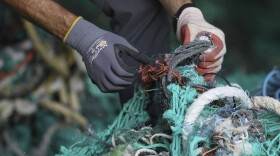Runners, bikers, and swimmers are descending on Kona this week. They’re joined by thousands of spectators, volunteers, media, and sponsor representatives. It's time for the Ironman Triathlon.
The triathlon is Saturday, with the 2.4-mile swim in Kailua Bay, the 112-mile bike ride up to Hawi and back, and the 26.2 mile marathon that stretches from around 4 miles south of Kailua Village to Kona's Natural Energy Lab. Race Director Diana Bertsch says one big change is how the race will start.
"Athletes will start checking in at 4:30 a.m. We have a swim wave start, for the first time, so we'll have 11 starts this year. The professional men, the professional women, we'll have our hand cycle and physically challenged athletes, and then we'll start into our age group athletes," she said.
Athletes will start from 6:30 a.m. to 7:30 a.m. Those staggered starts will also affect spectators.
"The athletes will be queuing up along Ali'i Drive. The logistics create challenges. The banyan tree on Ali'i Drive is the first entry point for the waves. Our team will get the athletes in the water and then they'll transition our swim start into the finish line," said Bertsch.
When the race had one mass start, the cutoff time was midnight. This year, it's 12:30 a.m. And each segment has a cutoff time.
"Each athlete has 2 hours 20 minutes to complete the swim, 10 hours 30 minutes to complete the bike, and a total of 17 hours to complete the race," she said.
The last Ironman impact study in 2006 estimated the event brings 20,000 people to town and generates $26 million in economic impact. In 2006, there were 1,500 racers. But this year, with 2,500 racers, it should be more.
Bertsch says Ironman, owned by the Chinese conglomerate Wanda Group, has commissioned a full economic impact study to get current numbers.
Details about road closures and athletes are available at ironman.com



